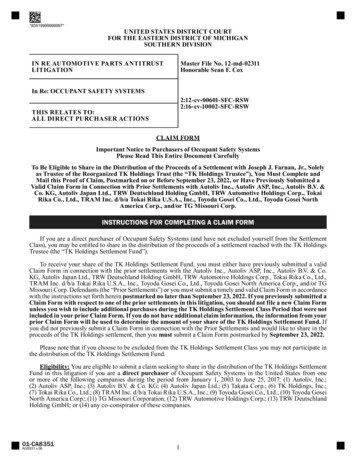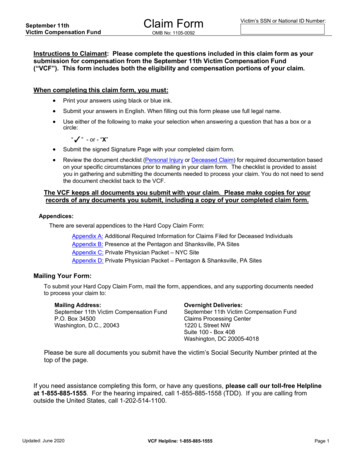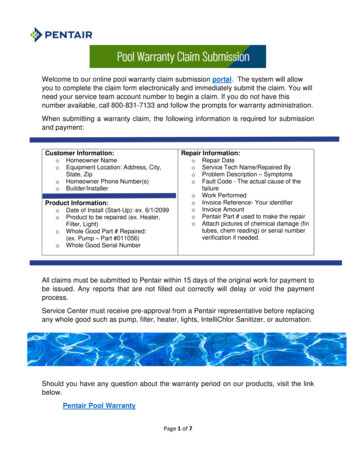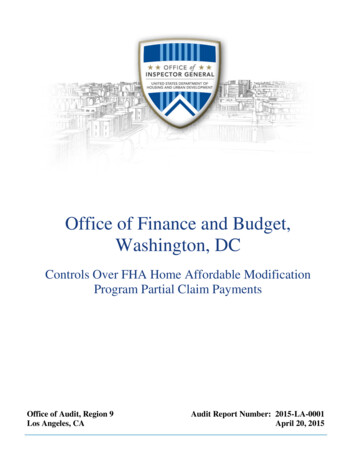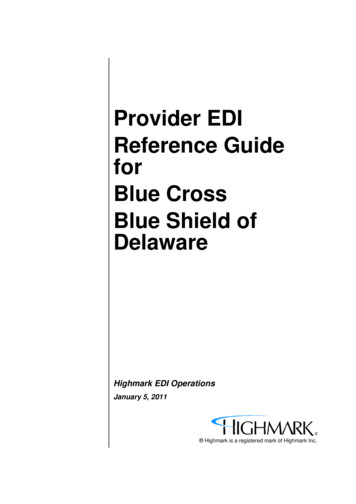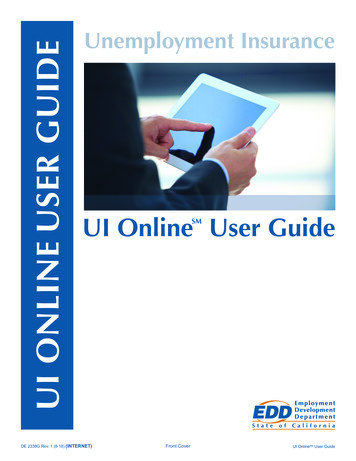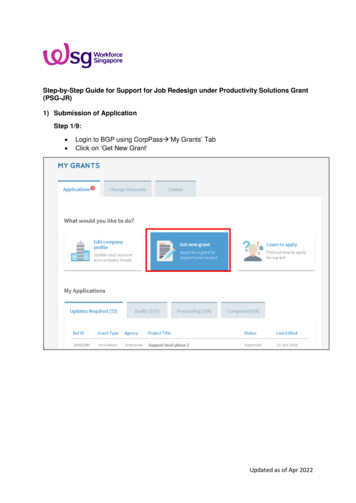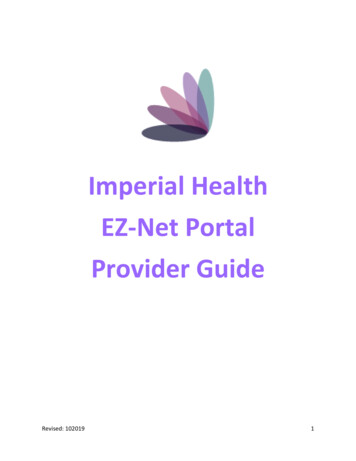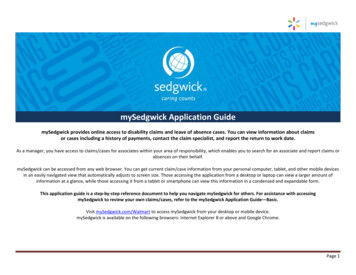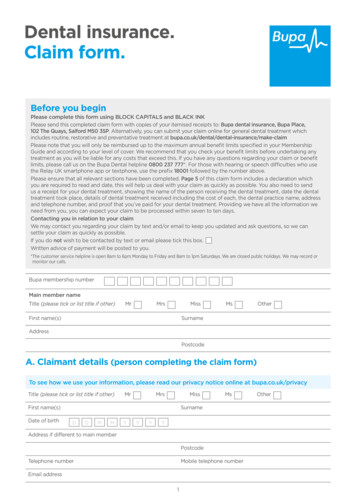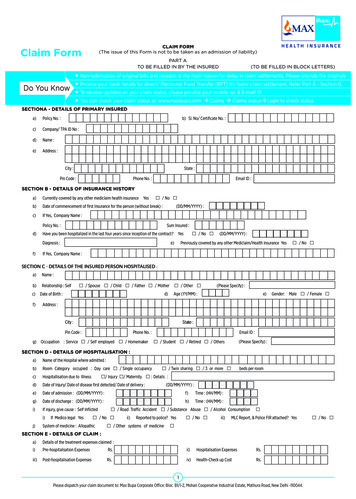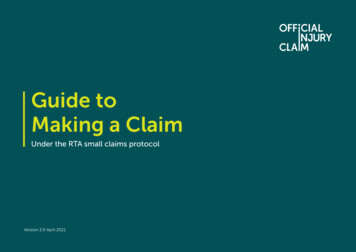
Transcription
OFFICIAL INJURY CLAIM Guide to Making a Claim (Version 2.0 April 2021)Guide toMaking a ClaimUnder the RTA small claims protocolVersion 2.0 April 20211
OFFICIAL INJURY CLAIM Guide to Making a Claim (Version 2.0 April 2021)2Contents1. Introduction1.1 The Official Injury Claim Service1.1.1 How to value a claim: taking account of non-protocol vehicle costs1.2 Purpose of the guide45.2 Losses2045.2.1 Compensation for your personal injury2045.2.2 Losses related to your personal injury2055.2.3 Losses due to property damage related to the accident215.2.4 Vehicle Costs211.2.1 What is it not for?51.2.2 Who is it for?51.2.3 What if your claim is over the value limits?55.3.1 Medical report fees222. Contacts75.3.2 Fees for any other experts223. Contents85.3.3 Police report fees224. How you can use this service114.1 Requirements to make a claim114.2 When you will not be able to use the portal124.3 Further instructions on portal use134.4 Valuation134.4.1 Whiplash valuation154.4.2 Non-whiplash valuation164.4.3 What if your claim is over the value limits?185. What you can make a claim for5.1 Introduction19195.3 Fees5.4 Limitation period6. How this service works2222236.1 Steps in the claims process236.2 Step 1: start246.2.1 Website and portal246.2.1.1 Official Injury Claim website246.2.2 What happens if you can’t use the portal or have accessibility needs256.3 Step 2: Investigation266.3.1 Responding to the compensator’s liability decision266.3.2 What happens if you can’t use the portal or have accessibility needs29
OFFICIAL INJURY CLAIM Guide to Making a Claim (Version 2.0 April 2021)6.4 Step 3: Medical3306.4.1 Portal choices when proceeding to medical306.4.2 Medical reports326.5 Step 4: Offer356.5.1. What you need to provide for the compensator to make you an offer356.5.2 How the compensator makes an offer366.5.3 The portal offer process386.5.4 Dispute over injury claim416.5.5 Withdrawal of offers416.5.6 Accepting offers previously rejected426.5.7 What happens if you can’t use the portal or have accessibility needs426.6 Step five: close process436.6.1 Claim closed436.6.2 Payment436.6.3 Go to court446.6.4 What happens if you can’t use the portal or have accessibility needs53Appendix54Tariff64
OFFICIAL INJURY CLAIM Guide to Making a Claim (Version 2.0 April 2021)1. IntroductionThis guide is designed to help youmake a personal injury claim onthe Official Injury Claim portal. Assuch, it explains the key legal termsand procedures used by the legalframework that underpins this service;the RTA Small Claims Pre-ActionProtocol.The guide has been reviewed bysenior independent legal counsel toensure it is both comprehensive andaccurate. If for any reason the guidedoesn’t provide the information yourequire, you can contact the PortalSupport Centre or seek advice(see 1.2.3.1).1.1 The Official InjuryClaim ServiceIf you want to make a personal injury claimrelated to a road traffic accident (RTA), then youmay be eligible to use the Official Injury Claimonline service (“the portal”). This is backed by theMinistry of Justice and handles claims of up to 5,000 for personal injury, and 10,000 whenyou include what are known as “other protocoldamages”. These are defined as losses, costs andexpenses (other than damages for injury) relatingto the accident (see section 4.4).If your personal injury claim is worth more than 5,000, or your claim (including injury and otherprotocol damages) is worth more than 10,000,then this portal is not the right place to startyour claim and you should seek advice, the costof which may be recoverable, your adviser willexplain the position on costs to you (see 1.2.3.1).Located at www.officialinjuryclaim.org.ukthe portal enables you to: self-manage your own claim from start tofinish without charge ask for additional contact centre support(known as the “Portal Support Centre”)41.1.1 How to value a claim: takingaccount of non-protocol vehicle costsYour first step in deciding whether your claim iseligible for this portal, is therefore to assess thevalue of your claim. Further information as tohow you do so is set out later in this guide.When deciding whether you can use this portal,you must assess the value of your claim. Furtherinformation as to how you do so is set out later inthis guide.You do not need to take account of non-protocolvehicle costs (NVC) as defined in the Pre-ActionProtocol when valuing your claim as these arenormally negotiated separately on your behalfoutside of the portal process. Examples of NVCare: sums your insurer has paid on your behalf suchas the cost of repairs and the write-off value ofyour vehicle. Hire or repair services provided on creditHowever, if you decide to go to court becauseyou could not reach agreement on your claim,then NVC should be included at that stage. Theportal will let you know what information youneed to provide.
OFFICIAL INJURY CLAIM Guide to Making a Claim (Version 2.0 April 2021)1.2 Purpose of the guideThe Guide to Making a Claim supports youthrough the process of making a personal injuryclaim on the portal. It does this by explaining anyrelevant legal terms and procedures you need toknow: for instance, those that relate to its legalframework, the RTA Small Claims Pre-ActionProtocol (“Pre-Action Protocol”).1.2.1 What is it not for?The Guide to Making a Claim does not provide: a screen-by-screen guide; you don’t need tolook at this guide as you make a claim a source of legal advice1.2.2 Who is it for?The Guide to Making a Claim is for: unrepresented claimants (those notrepresented by an advisor) pro-users (professional users who representclaimants) and advice providers who may wishto refer to it English and Welsh speakers. It will also beavailable for translation via the Portal SupportCentre into any of the top 10 most requestedforeign languages in England and WalesThe guide uses the term ‘you’ and ‘your’ torefer directly to the claimant (also known asunrepresented claimant), unless otherwisespecified. a means to help you value your claim a guide for vulnerable customers (see section6.2.2) – if you fall into this category you will beable to seek assistance/help by getting in touchwith our Portal Support Centre a guide to every single customer journey(i.e. pathways through the portal)1.2.3 What if your claim is over thevalue limits?If your personal injury claim is worth more than 5,000, or your claim (including injury and otherprotocol damages – see 1.1) is worth more than 10,000, then this portal is not the right place tostart your claim and you should seek advice, thecost of which may be recoverable. Your adviserwill explain the position on costs (see 1.2.3.1).5Remember: if non-protocol vehicle costs areincluded at this stage, that may mean your totalfigure comes to more than 10,000 and you maybe able to get legal advice (see 1.2.3.1). However,you can still use the portal as long as the injuryand protocol damages are within the limits setabove (see 1.1.1).1.2.3.1 Seeking adviceThere are various sources of advice you could useincluding your own insurer or legal adviser. Youmay be able to obtain legal advice without anyupfront cost, or there may be a cost payable. Youradviser will be able to guide you on any paymentsthat you must make to them and when andwhether you can recover any of your legal costsfrom the other party.Legal costs are not usually recoverable at allwhen your claim proceeds via this portal. If yourclaim is not one that should be proceeding withinthis portal, either because of value or some otherreason, you may be able to get legal advice andyour legal adviser will explain the position oncosts to you.
OFFICIAL INJURY CLAIM Guide to Making a Claim (Version 2.0 April 2021)61.2.3.2 Pre-Action Protocol (PAP) references to the Guide to Making a ClaimThe Road Traffic Accident (RTA) Small Claims Pre-Action Protocol makes several references to the Guide to Making a Claim. If you are coming to the guidefrom the Pre-Action-Protocol, the following table will direct you to the relevant guide reference:PAPref.Pre-Action ProtocolstatementGuideref.PAPref.Pre-Action ProtocolstatementGuideref.PAPref.Pre-Action ProtocolstatementGuideref.4.5 (3)The Guide to Making aClaim provides furtherinformation on valuingthe claim4.457.3.3Where there is mentionof non-protocol vehiclecosts. The Guide toMaking a Claim providesfurther information onvaluing the portal 4.1.36.4.1.46.4.26.4.2.16.4.2.211.6.2The Guide to Makinga Claim provides moreinformation on makingcounter offersThe Guide to Makinga Claim provides moreinformation on obtaininga medical report (7.3.3)and on obtaining medicalreports where these arenot provided via Medco(7.7.2)12.1.5The Guide to Makinga Claim providesmore informationabout applying for adetermination of .5.27.13 (5)The Guide to Makinga Claim gives moreinformation aboutnotifying a medical expertregarding the factualaccuracy of a report6.4.2Where there is mentionof court proceedings(go to court), The Guideto Making a Claim givesmore information aboutthe steps that a claimantmust take before startingcourt 46.6.3.58.8.2Claims above the valuelimit: The Guide toMaking a Claim givesmore information aboutthe steps available to aclaimant1.2.36.8.76.12.77.7.24.4.3
OFFICIAL INJURY CLAIM Guide to Making a Claim (Version 2.0 April 2021)2. ContactsFor help and support, phone us on0800 118 1631The Portal Support Centre is openMonday to Friday from 9am to 5pm.Address:Official Injury Claim LimitedLinford Wood House6-12 Capital Drive, Linford WoodMilton KeynesMK14 6XT7
OFFICIAL INJURY CLAIM Guide to Making a Claim (Version 2.0 April 2021)83. ContentsThe main sections of the guide are as follows:Section 4:Section 5:Section 6:In outlining this process, the guidedescribes:How you can usethis serviceWhat you can makea claim forHow this serviceworksThis section describes how youcan make a claim using this service(the portal and supporting PortalSupport Centre). To do so you mustmeet the requirements laid outin this guide and in the protocol.You also have the choice to usea professional such as a solicitoror claims management company,which may cost you money.This section outlines the typesof claims for personal injury andassociated losses that you canmake.The section outlines the 5-stepprocess to making a claim. Theseare: the main actions you needto take on the portal, such aswhich buttons to click and whatinformation is displayed on keyscreens (there is an example fromthe claim overview screen below)Step 1: startStep 2: investigationStep 3: medicalStep 4: offerStep 5: close process some of the important questionsyou need to answer as you workthrough your claim on the portal some key legal and claim terms,such as the term ‘compensator’ the reasons for leaving the portalIn each section we explain therelevant workings of the protocol.** If there is any difference between this guide andthe protocol, the protocol takes precedence.
OFFICIAL INJURY CLAIM Guide to Making a Claim (Version 2.0 April 2021)9Example: Claim overview screenWhen you log intothe portal and openyour claim you willarrive at the ‘Claimoverview’ screen.On the ‘Claimoverview’ screen, youcan always see thestage reached or thenext action to take.Any in-systemmessages can beviewed here; if thereis a new message itwill be highlighted inyellow.At each point, youwill be able to seewhich of the keystages you havereached or passed.As you progressthrough the portal,various documentswill be generated.You may uploadsome; the systemwill generate others;they can be viewed,downloaded andprinted here.
OFFICIAL INJURY CLAIM Guide to Making a Claim (Version 2.0 April 2021)This screen canbe found at thebottom of theclaim overviewas well as mostother screens.10You will be ableto find details ofyour claim withinthese tabs. As youprogress throughthe portal, detailswill be updated.
OFFICIAL INJURY CLAIM Guide to Making a Claim (Version 2.0 April 2021)4. How you can use this service4.1 Requirements to makea claimYou can make a claim through the portal if: you are making a personal injury claimof up to 5,000 the value of your claim (including your injuryand other protocol damages) is not more than 10,000 you are aged 18 or over when the claim isentered onto the portal the accident happened in England or Wales the accident happened on or after[31st May 2021] you were inside a vehicle you believe someone else was responsibleeither in full or in partfor the accident you have the vehicle details of the personwho caused the accident the driver at fault was in a vehicle witha UK registration number plateIf your personal injury claim is worth more than 5,000 or your claim (including injury and otherprotocol damages (see 1.1) is worth more than 10,000 then this portal is not the right place tostart your claim and you should seek advice (youradviser will explain the position on costs to you(see 1.2.3.1)).Remember: if NVC are included at this stage, thatmay mean your total figure comes to more than 10,000 and you may be able to get legal advice(see 1.2.3.1). However, you can still use the portalas long as the injury and protocol damages arewithin the limits set above (see 1.1.1).11
OFFICIAL INJURY CLAIM Guide to Making a Claim (Version 2.0 April 2021)4.2 When you will not be ableto use the portal your claim is in respect of a breach of dutyowed to a road user by a person who is not aroad userSection 4.3 of the Pre-Action Protocol, describeswhen you will not be able to use the portal. your claim is against an untraced driver asdefined by the Untraced Drivers’ Agreement2017 or any subsequent or supplementaryUntraced Drivers’ AgreementsIn brief, you (as the claimant) will not be able touse the portal and will need to seek advice if: your injury claim is over 5,000, or togetherwith other protocol damages your claim is over 10,000 you are a protected party. A protected party isone defined by the Pre-Action Protocol (see4.3(g)) as a “party, or an intended party, wholacks capacity to conduct proceedings” (link) you have a personal injury and you were notinside a vehicle, for instance on a motorbike orbicycle your injuries were partly caused by thedefendant’s breach of section 53 of the Healthand Safety at Work etc Act (1974), for exampleyou were injured falling from a roof while atwork you were a vulnerable road user at the time ofthe accident, for example a motorcyclist, pillionpassenger, passenger in a sidecar attachedto a motorcycle, wheelchair or poweredwheelchair user, on a mobility scooter, on abicycle or other pedal cycle, riding a horse or apedestrian either you (as claimant) or the defendant is apersonal representative of a deceased person you are currently bankrupt the defendant’s vehicle is registered outsidethe United Kingdom12In these circumstances you should seekindependent advice and assistance, for examplefrom a legal representative or your insurancecompany, the cost of which may be recoverablefrom the compensator. Your adviser will be ableto guide you on whether you can recover any ofyour legal costs from the other party.
OFFICIAL INJURY CLAIM Guide to Making a Claim (Version 2.0 April 2021)4.3 Further instructions onportal useThere are some situations where the portal willgive you further instructions on next steps: if you have a personal injury but do not havethe registration number of the vehicle. In thisinstance, the Motor Insurers’ Bureau might beable to help if you have a personal injury and the vehicleyou believe was responsible had foreignnumber plates, the Motor Insurers’ BureauGreen Card might be able to help4.4 ValuationRemember: you may wish to seek further adviceor guidance on the value of your claim(see 1.2.3.1)You can use the portal if: you are making a personal injury claim of up to 5,000 the value of your claim (including yourpersonal injury claim and other protocoldamages) is not more than 10,000(see table on the next page)Your first step, then, is to assess the value of yourclaim to see if you should be using this portal.The value will depend on both your injury and anyother losses incurred as a result of the accident orinjury. The table below sets out what you need toconsider when assessing the value of your claim.As part of this process, you will also be requiredto get a medical report from an accreditedmedical expert. However, it often isn’t clearshortly after an accident and before you getyour medical report how long any injuries mighttake to resolve. So, you can revisit and amendthe value of your losses (not your injury) as yougo through the portal, right up until you ask thecompensator for an offer.If it becomes clear later that you are notrecovering and your claim may exceed the levelsoutlined above, it would be best to seek separateadvice about whether this portal remains thebest place for your claim. An adviser will be ableto inform you about the cost and whether anyof that cost is recoverable from the responsibledriver.It should be noted when considering the valueof your injury that the vast majority of whiplashclaims and most other soft tissue injuries will bevalued at less than 5,000.13
OFFICIAL INJURY CLAIM Guide to Making a Claim (Version 2.0 April 2021)14The table below sets out what you can claim for. You will need to be able to prove each item claimed for eitherby keeping receipts (for example for travel) or via the medical report for your injury:WhiplashSeeSection4.4.1. Whiplashand minorpsychologicalinjurySeeSection4.4.1. Uplift inexceptionalcircumstancesSeeSection4.4.1.1 If you have suffered a whiplash injury (or injuries) to yourneck, back or shoulder this will be valued by referenceto a whiplash-only tariff set by law). The medical expertwill set out in the medical report how long you havesuffered, will suffer or are likely to suffer with your injury;you can cross reference that information against thetariff. You won’t know exactly how long you are likely tohave your injury (or injuries) until you have your medicalreport, but you will be able to provide an approximateindication of the value of your claim by considering thetariff.If as well as a whiplash injury (or injuries) you believeyou may have had a minor psychological injury, suchas shock or travel anxiety, your claim is still valued byreference to a whiplash and minor psychological injurytariff. Otherwise the same points made in the whiplashsection above apply.Where you have a whiplash injury or whiplash injury withminor psychological injury and the injury/injuries youhave sustained is/are exceptional, you may be entitledto an uplift of up to 20% of the tariff sum. You shouldexplain why you think your injury is exceptional to yourmedical expert, who will comment on the issue. To beexceptional the injury must be exceptionally severe and/or your circumstances have increased your suffering asa result of the whiplash injury (and those circumstancesare exceptional).Non-whiplashinjurySeeSection4.4.2. Otherprotocoldamages –injury relatedSeeSection5 Otherprotocoldamages– propertydamageSeeSection5 If you have suffered an injury that is not whiplash (forexample a broken finger), then the tariff will not applyto your injury claim or that part of your injury claim ifyou have suffered a whiplash injury and a non-whiplashinjury. You should review the relevant sections of theJudicial College Guidelines (JCG) which will give youan indication of the likely value of this part of your claim(Link). As there is no tariff for non-whiplash injury, youwill need to negotiate the value of the non-whiplashinjury with the compensator once you have requestedan offer. The JCG provides you with a starting point forthat negotiation and for valuing your claim at the outset.You may have incurred losses as a result of your injury(for example loss of earnings, travel costs for attendingmedical appointments, prescriptions, physiotherapy).You should keep receipts for these items where possibleor obtain proof for other items (for example loss ofearnings).You may have incurred losses as a result of the accident(for example the cost of repairs that you have paidyourself, damage to property that was in the car at thetime of the accident, loss of earnings because you needyour damaged car to work). You should keep receiptsfor these items where possible or obtain proof for otheritems (for example loss of earnings).
OFFICIAL INJURY CLAIM Guide to Making a Claim (Version 2.0 April 2021)Once you have collated all information aboutthe value of your claim you should first checkthat the likely value of your personal injury claimis less than 5,000. If you are satisfied that is thecase, you must then check that when you addthe value of the other protocol damages (injuryrelated and property damage), the overall amountis less than 10,000.You should note that where you have nonprotocol vehicle costs (NVC) (see 1.1.1). Theseare not counted as part of the value of your claimwhen deciding if you can use the portal. Yourinsurer or the other organisation will usually seekto recover these losses separately on your behalf.If, after you have requested an offer fromthe compensator, you are unable to reach asettlement, the non-protocol vehicle costs(NVC) will need to be added to your claim beforeyou go to court. Should you reach that stage,the portal will guide you through obtaining thisinformation.Remember: until you get your medical report, anyvaluation of your claim is provisional.If you believe that the value of your claim will beover the value bands set out above, the portal isnot the right place to start your claim and youmay wish to seek advice (see 1.2.3.1).154.4.1 Whiplash valuation4.4.1.1 Uplift in exceptional circumstancesWhat is meant by a ‘whiplash Injury’ is set out inthe Civil Liability Act 2018, Part 1, which can beaccessed here (Civil Liability Act 2018).If your personal injury is for whiplash, you may beable claim an ‘uplift’ on the tariff amount statedfor the whiplash injury/injuries. The maximumuplift allowed is 20% of the tariff amount.Any whiplash injury (or injuries) of the neck, backor shoulder which recover fully within 2 years arevalued through a fixed tariff set out here. If youhave whiplash injuries to both neck and back,the tariff amount relates to both of these injuriesand to determine the correct amount you lookto the more severe injury. If, in this example thewhiplash injury to the back fully recovers within2 months and the neck within 7 months, thecorrect tariff amount for your injury will be in themore than 6 months but no more than 9 monthsbracket.There is a separate tariff where, in addition tothe whiplash injury/injuries, you also suffer anyminor psychological injury such as minor shockor travel anxiety. If you suffered a more seriouspsychological injury, that should be valuedseparately.The tariff will next be reviewed in 2024 at theearliest.However, you can only claim this in exceptionalcircumstances. This means you will need toprove that the degree of pain, suffering or loss ofamenity (the impact of your injuries on your dayto-day life) caused by the whiplash injury/injuriesmeans that this is appropriate.For instance: the whiplash injury or one or more whiplashinjuries is exceptionally severe your circumstances have increased the pain,suffering or loss of amenity caused by theinjury/injuries those circumstances are exceptionalIf you do decide to make a claim for an uplift, youmust explain: how you meet the ‘exceptional circumstances’criteria what percentage uplift you are claiming
OFFICIAL INJURY CLAIM Guide to Making a Claim (Version 2.0 April 2021)You should provide supporting evidence for yourrequest. If you intend to use the medical reportas evidence, you should ensure it captures theinformation about the exceptional circumstances.4.4.2 Non-whiplash valuationAs a result of your accident, you may havesustained a whiplash injury and/or a nonwhiplash injury (for example a broken finger).There is no fixed tariff for the non-whiplash injuryand you will need to consider the valuation ofthat element of your claim separately to any tariff.A guide called the Judicial College Guidelines(JCG) may help with this, or you may wish to seekadvice, which you may need to pay for.The relevant sections of the JCG can be found(here).The The JCG is usually updated every 2 yearsand sets out appropriate settlement bracketsfor different types of injury. The figures maychange during the course of your claim and youshould recheck them before you agree your finalsettlement with the compensator. However, itprovides a good guide for your initial estimate ofyour claim value.You should note that the figures set out in theJCG are guides only and where you have multiplenon-whiplash injuries you will not be offered asum for each injury, but a total which representsthe combined extent of the overall injurysustained.If you have a whiplash and non-whiplash injuryyou will be offered the tariff amount for thewhiplash injury and a separate sum for the nonwhiplash injury. The courts are yet to decidehow the tariff and sums for other injuries shouldbe assessed when considered together and theguide will be updated when the courts haveclarified this.The JCG provides quite detailed explanationsof types of injuries. You can find the relevantsection of the JCG by searching against the areaor type of injury (for example leg, teeth, scarringor psychiatric). Once you have located the rightarea, you need to look at the description of theinjury to decide which fits most closely with yoursymptoms.In addition, if you fully recover from your injurywithin 3 months, you should also look at theminor injury section. This is relevant where youhave an ongoing injury such as a soft tissue injuryto your knee. However, this is not relevant whereyou have a ‘one off’ injury such as loss of a tooth.16When you look at the guide, you will see thatsome of the brackets are quite wide. To be ableto put a value on your injury you will need toconsider the text provided in the JCG to givecontext to your injury, or you may need toconsider the brackets either side to decide whereyour injury fits best.For example, if you have minor cuts andabrasions on your legs and are fully recoveredwithin 10 days, you would look at the minor injurysection. The diagram below shows a simple wayof calculating your claim.
OFFICIAL INJURY CLAIM Guide to Making a Claim (Version 2.0 April 2021)This shows a bracket of figures for fullrecovery within 7 days, and a secondbracket of figures for full recoverywithin 28 days. You would value yourclaim by reference to bracket 2 buttowards the lower end of the bracket,noting that the previous bracketcovered up to 7 days.17 1,290 6500-7 Days8-28 Days7 Days10 days28 days
OFFICIAL INJURY CLAIM Guide to Making a Claim (Version 2.0 April 2021)4.4.3 What if your claim is overthe value limits?If your injury claim is worth more than 5,000or your claim (including injury and other protocoldamages (see 1.1) is worth more than 10,000then this portal is not the right place to start yourclaim and you should seek advice (your adviserwill explain the position on costs to you(see 1.2.3.1)).Remember: if NVC are included at this stage, thatmay mean your total figure comes to more than 10,000 and you may be able to get legal advice(see 1.2.3.1). However, you can still use the portalas long as the injury and protocol damages arewithin the limits set above (see 1.1.1).4.4.3.1 Seeking adviceThere are various sources of advice you could use– for instance your own insurer or legal adviser,although you may need to pay for a legal adviser’sservices. Your adviser will be able to guide you onwhether you can recover any of your legal costsfrom the other party.18
OFFICIAL INJURY CLAIM Guide to Making a Claim (Version 2.0 April 2021)5. What you can make a claim for5.1 IntroductionYou can claim for personal injuryand other accident-related damages(known as other protocol damagesor losses, see 5.2). You can also claimfor any fees you have had to pay (forexample a police report fee). If youneed to pay any court fees you canalso seek to recover this cost fromthe compensator, although with courtfees, you may qualify to have thesereduced or waived depending on yourfinancial circumstances.19
OFFICIAL INJURY CLAIM Guide to Making a Claim (Version 2.0 April 2021)5.2 LossesThe types of losses you can claim for are shown in the claim capture process below:Type of lossesType of lossExamples of relevant evidenceProperty- repairs/total lossRepair invoice or estimate, engineer’s report photographs of damageProperty- storage/recoveryRecovery/storage invoiceProperty- temporary vehicleHire invoiceProperty- loss of useDetails of dates on which you were without the use of your vehicleProperty- travel expenseTravel receipts (Taxi, bus train)Property- excessConfirmation of policy excess paymentProperty- diminutionEngineer’s report, cost of repairs, photographs of damageProperty- other itemsReceipts, estimates, photographs of damageInjury related- treatment costsReceipts from treating expertInjury related- prescription costsCosts of medicationInjury related- loss of earningsLetter from employer, wage slips, accountsInjury related- care costsDetail of hours spent, receipt for care receivedInjury related- travel costsReceipts for travel to and from GP/hospital/ treatment appointmentsInjury related- other costsAny other receipts, estimates205.2.1 Compensation for your personalinjuryEvidence of your whiplash injury must be in theform of a medical report (see 6.4) and, whereyou have a non-whiplash injury, the evidencewill usually be in the form of a medical report aswell. The portal will assist you in obtaining yourmedical report or advise you on the process.Remember: you might have whiplash injuries,where compensation is decided by the tariffsystem, or non-whiplash injuries, where thecompensation sums
If you want to make a personal injury claim related to a road traffic accident (RTA), then you may be eligible to use the Official Injury Claim online service ("the portal"). This is backed by the Ministry of Justice and handles claims of up to 5,000 for personal injury, and 10,000 when you include what are known as "other protocol damages".
